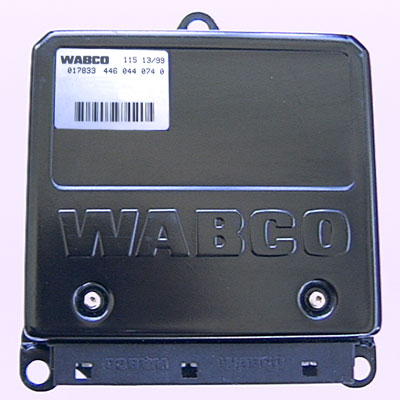Choice of outputs that can be tested. Each output has an ON and OFF choice. Click on the ON link to start the test and on OFF to end.
- Valves: This turns on the output to the ABS valves (front/rear left/right inlet/outlet).
- Pump relay: This turns on and off the ABS pump relay output.
- Valve relay: This turns on and off the ABS valve relay output.
- Brake warning LED: This turns on the brake warning lamp for 20 seconds. The brake or EBD lamp is a combined warning lamp with the low brake fluid warning and the handbrake warning lamp. The lamp is a red light with an exclamation mark inside a brake symbol. The ABS ECU will illuminate this light if it senses a fault that will affect its ability to control the braking balance of the vehicle. This lamp will be illuminated for 3 seconds when the ignition is switched on, as a bulb check function. It will then extinguish as long as no fault currently exists that may effect the operation of the EBD. The EBD warning lamp will remain illuminated if the ABS ECU is in "new-born" mode. Unlike the ABS warning lamp, the ABS ECU supplies a voltage to illuminate the light, not to turn it off. Modes of operation:
- No lamp and no audible warning indicate that the ABS/EBD/TC and HDC systems are OK.
- The lamp being on could indicate that the ignition has just been turned on (Bulb check for 3 seconds), the handbrake is on, there is a low brake fluid level, the ABS ECU supplied voltage is much too high or much too low‚ there is a new-born ABS ECU fitted, the ABS has a sensor/pump or valve fault logged for this journey.
- Both lamp on and the audible warning indicates that the ABS has detected a sensor/pump or valve fault.
- ABS warning LED: The ABS warning lamp is an amber light with the letters ABS inside a circle. If there is a fault the ABS warning lamp will remain illuminated until the ignition is switched off.
- Traction control lamp: The ETC system employs one amber lamp, which has the letters TC in a dotted circle. The lamp will illuminate during the ignition on lamp check. The system will indicate TC operation by illuminating the amber TC lamp for a minimum of 2 seconds.
- Speedometer: This drives the speedometer output to simulate 100 Miles per hour.
- HDC information LED: This lamp is used by the HDC system to indicate that the system is switched on and ready to assist with descents, when necessary.
- HDC fault LED: This turns on the output for the HDC fault lamp/LED. The HDC amber lamp is used to indicate a fault with the system. The graphic is the same as the green HDC light, but has an additional exclamation mark next to it. The moment a fault appears that will affect the operation of the HDC function, an audible warning is sounded, similar to the ABS fault warning, and the amber light will be illuminated.
|
 WABCO D TYPE (DEFENDER) - System Overview
WABCO D TYPE (DEFENDER) - System Overview WABCO D TYPE (DEFENDER) - System Overview
WABCO D TYPE (DEFENDER) - System Overview SM033 - WABCO D TYPE (DEFENDER) - System Help file
SM033 - WABCO D TYPE (DEFENDER) - System Help file WABCO D TYPE (DEFENDER) - Known Fitments
WABCO D TYPE (DEFENDER) - Known Fitments WABCO D TYPE (DEFENDER) - Physical Details
WABCO D TYPE (DEFENDER) - Physical Details
 WABCO D TYPE (DEFENDER) - Pin Outs
WABCO D TYPE (DEFENDER) - Pin Outs SM033 - WABCO D TYPE (DEFENDER) - Diagnostic Capabilities (Read Fault Codes)
SM033 - WABCO D TYPE (DEFENDER) - Diagnostic Capabilities (Read Fault Codes) SM033 - WABCO D TYPE (DEFENDER) - Diagnostic Capabilities (Clear Fault Codes)
SM033 - WABCO D TYPE (DEFENDER) - Diagnostic Capabilities (Clear Fault Codes) SM033 - WABCO D TYPE (DEFENDER) - Diagnostic Capabilities (Settings)
SM033 - WABCO D TYPE (DEFENDER) - Diagnostic Capabilities (Settings) SM033 - WABCO D TYPE (DEFENDER) - Diagnostic Capabilities (Inputs)
SM033 - WABCO D TYPE (DEFENDER) - Diagnostic Capabilities (Inputs) SM033 - WABCO D TYPE (DEFENDER) - Diagnostic Capabilities (Outputs)
SM033 - WABCO D TYPE (DEFENDER) - Diagnostic Capabilities (Outputs) SM033 - WABCO D TYPE (DEFENDER) - Diagnostic Capabilities (Other)
SM033 - WABCO D TYPE (DEFENDER) - Diagnostic Capabilities (Other)